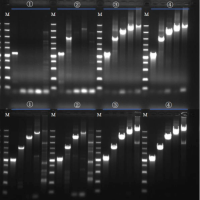About agarose:
Agarose is linked by 1, 3 β- D-galactofuranose and 1,4-linked 3,6-dehydration α- L-galactofuranose is linked with each other. Agarose is hydrophilic, almost completely free of charged groups, rarely adsorbs biological macromolecules and rarely causes their denaturation. It is an ideal inert carrier. Agarose is generally heated to above 90 ℃ in water to dissolve, and the temperature drops to 35-40 ℃ to form a good semi-solid gel. Agarose gel is the most commonly used separation medium, used as electrophoresis and chromatography carrier to separate biological macromolecules (nucleic acids, proteins, polysaccharides, etc.).
Advantages of agarose gel:
- The sample does not need pretreatment, the electrophoresis operation is simple, and the electrophoresis speed is fast.
- The gel structure was uniform, the electropherogram was clear, the resolution was high, and the reproducibility was good.
- The gel is transparent without UV absorption, and the electrophoresis results can be directly monitored under UV light.
- It is easy to stain, sample is easy to elute, and it is convenient for quantitative determination. The dry film can be preserved for a long time.
Preparation method of agarose gel:
- According to the needs of electrophoresis, prepare electrophoresis buffer.
- Add accurately weighed agarose into the triangular flask, add electrophoresis solution (1% agarose gel, i.e. 1g agarose, add 100ml 1 × TAE). The total liquid volume should not exceed 50% of the volume of the triangular bottle
- Heat the microwave oven with high fire until boiling, keep it for 30 seconds, wear heat resistant gloves, carefully shake the flask, resuspend the undissolved particles, and heat it again with high fire for 1-2 minutes until the agarose is completely dissolved.
Note: stop heating if the glue liquid boils violently and foams during heating. The heating time in the microwave oven should not be too long. - When the solution is cooled to about 60 ℃, EB solution can be added (the final concentration is 0.5ug/ml, and other nucleic acid dyes can also be used) and fully mixed.
- Pour the agarose solution into the glue making mold and insert a comb at the appropriate position. The gel thickness is generally between 3-5mm.
- Set naturally at room temperature (about 30-60 minutes), and then place it in the electrophoresis tank for electrophoresis.
Note: the gel is not used immediately. It can be stored at 4 ℃ for 2-5 days after being wrapped with fresh-keeping film.
Agarose concentration and DNA separation range:
| Agarose concentration% | Linear DNA (KB) |
| 0.3 | 25-5 |
| 0.6 | 20-1 |
| 0.7 | 10-0.8 |
| 0.9 | 7-0.5 |
| 1.2 | 6-0.4 |
| 1.5 | 4-0.2 |
| 2.0 | 3-0.1 |
Trouble shotting:
When agarose is dissolved in the microwave oven, what should we do if the glue liquid boils violently and overflows the conical flask?
- The total liquid volume should not exceed 50% of the capacity of the triangular conical flask.
- If the glue concentration is more than 2%, please set medium fire heating.
- When the glue liquid boils violently, stop heating, wear heat resistant gloves and carefully shake the flask, and then heat it again until the agarose is completely dissolved and the glue liquid is clear.
Causes and solutions of agarose electrophoresis image background blur
If agarose is not completely dissolved, the background of electrophoresis image will be blurred. For completely dissolved agarose, there should be no agarose particles adhered to the inner wall of the flask.
Causes and solutions of fuzzy and tailing DNA bands
- DNA degradation. Samples should be kept away from too long and nuclease contamination.
- Excessive sample loading. Reduce sample loading.
- Electrophoresis buffer failed. The ionic strength of the electrophoresis buffer used for many times decreases, the pH value increases, and the buffer capacity weakens, affecting the electrophoresis effect. It is recommended to replace the electrophoresis buffer.
- The electrophoresis conditions were inappropriate. During electrophoresis, the voltage should not exceed 20v/cm, the temperature should be < 30 ℃, and the temperature of ultra long DNA strand should be < 15 ℃.
- The salt content of DNA is too high. Excess salt was removed by ethanol precipitation before electrophoresis.
- Protein contamination. Proteins were removed by extraction before electrophoresis.
- DNA denaturation. Do not heat before electrophoresis, and dilute DNA with 20mm NaCl buffer.
Causes and solutions of weak or no DNA bands
- Insufficient sample loading. Increase the loading volume.
- DNA degradation. Avoid nuclease contamination of DNA.
- DNA runs out of the gel. Shorten the electrophoresis time, reduce the voltage, and enhance the gel concentration.
- DNA bands with similar molecular sizes are not easy to distinguish. Increase the electrophoresis time and use the correct gel concentration.
- DNA denaturation. Do not heat the DNA strand at high temperature before electrophoresis, and dilute the DNA with 20mm NaCl buffer.
- The DNA strand is too long and conventional gel electrophoresis is not suitable. Analyzed on pulsed gel electrophoresis.
Causes and solutions of DNA marker strip distortion
- The buffer for gel preparation and the buffer for electrophoresis are not prepared at the same time. Use the buffer prepared at the same time, and the buffer is 1-2mm higher than the gel.
- The voltage is too high during electrophoresis. The lower voltage (3v/cm) can be used 15 minutes before electrophoresis, and then the voltage can be adjusted higher after the strip exits the hole.
- Try to add the sample slowly and wait for the sample to settle naturally before adding the voltage.
About low melting point agarose
Low melting point agarose is agarose modified by hydroxyethyl, methoxy and other groups on the polysaccharide chain. It can gel at about 30 ℃, melt at about 65 ℃, and the melting temperature is lower than the unwinding temperature of most double stranded DNA. Using this property of low melting point agarose, the natural form of DNA can be recovered from the gel. The product is easy to dissolve and can be prepared with up to 4% gel. The gel solution is clear and has a very high resolution. The gel has higher screening characteristics and is more transparent. It is an ideal small fragment DNA (less than 1KB) and RNA electrophoresis product, which is suitable for gel recovery; It is also suitable for in gel enzymatic reaction, tissue culture, cell cloning and virus plaque analysis.
About high-resolution agarose:
PCR grade high resolution agarose has extremely high resolution for PCR products and small fragments of DNA. It is suitable for DNA electrophoresis below 1000bp, and the resolution is about 2% of the size of DNA fragments. The gel solution is clearer and can be prepared with up to 5% gel. The resolution of high-resolution agarose gel (2%-4%) is close to that of polyacrylamide gel (4%-8%), which is suitable for separating 20bp-800bp DNA fragments. It is suitable for STR analysis and RT-PCR analysis.



